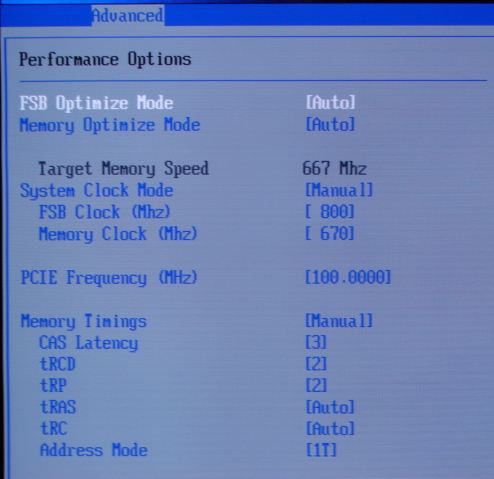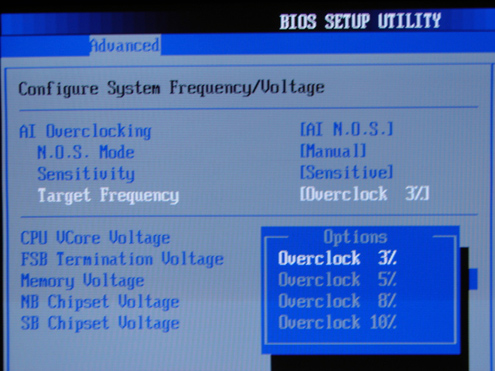Asus P5N32-SLI: Dual x16 - What Dreams Are Made On . . .
by Gary Key on October 27, 2005 12:05 AM EST- Posted in
- Motherboards
Basic Features: Asus P5N32-SLI Deluxe
The Asus P5N32-SLI Deluxe is a member of the ALife product family and, as such, is a fully-featured flagship board targeted towards the PC gamer. The board ships with an extensive accessory package along with several dynamic overclocking features such as AI NOSTM (Non-delay dynamic Overclocking System), AI Overclocking (intelligent CPU frequency tuner with preset profiles), ASUS PEG Link (automatic performance tuning for single/dual graphics cards), ASUS CPU Lock Free (BIOS setting to unlock select multiplier locked CPUs), and the ASUS Ai Booster Utility Precision Tweaker software that allows control over certain system settings within Windows. The board also features the exclusive 8-Phase power design, Copper Heat Pipe technology for cooling the chipsets, Stack Cool 2 design to dissipate heat to the opposite side of the motherboard, and an external SATA II port on the back I/O panel.
| Specification | Asus P5N32-SLI Deluxe |
| CPU Interface | LGA775-based Pentium 4, Pentium XE, Celeron D, and Pentium D processors. |
| Chipset | North bridge- NVIDIA nForce 4 SLI Intel Edition (Crush C19) South bridge- NVIDIA nForce 4 SLI Edition (Athlon CK804) |
| Pentium D Support (Dual-Core) | Full Support |
| Front Side Bus | 1066 / 800 / 533 MHz |
| Front Side Bus Speeds | 533-1600 MHz (in 1 MHz increments) |
| Memory Speeds | Auto- 400-1200 MHz (in 1 MHz increments) |
| System Clock Mode | Optimal, Linked, Expert |
| PCI Express | 100 MHz to 150 MHz in 1 MHz increments |
| Dynamic Overclocking | AI NOSTM (Non-delay Overclocking System) AI Overclocking (intelligent CPU frequency tuner) ASUS PEG Link (Automatically performance tuning for single/dual graphics cards) ASUS CPU Lock Free ASUS Ai Booster Utility Precision Tweaker for Windows |
| Core Voltage | Auto, 1.1V - 1.70V in 0.0125V increments |
| DRAM Voltage | Auto, 1.85 - 2.4V in 0.05V to 0.10V increments |
| Other Voltage | North Bridge - Auto, 1.4V, 1.5V, 1.6V South Bridge - Auto, 1.5V, 1.6V FSB - Auto, 1.215, 1.315, 1.415 |
| LDT (Hyper Transport) Ratios | 200, 400, 600, 800, 1000 |
| Memory Command Rate | Auto, 1T, 2T (current BIOS defaults to 2T) |
| Memory Slots | Four 240-pin DDR2 Slots Dual-Channel Unbuffered Memory to 16GB |
| Expansion Slots | (2) x16 PCIe Slots (1) x4 PCIe Slot (2) x1 PCIe Slots (2) PCI Slots version 2.2 |
| SLI | (2) x16 Fully Supported |
| Onboard SATA | (4)-Drive SATA 2 by nForce 4 |
| Onboard IDE | (2) ATA 133/100/66/33 ports, (4) drive support by nForce 4 |
| SATA/IDE RAID | NVIDIA® nForce4 SLI supports NVRAID - 2 x Ultra DMA 133/100/66/33 - 4 x Serial ATA 3 Gb/s - NVRAID: RAID0, 1, 0+1, 5, and JBOD Silicon Image® 3132 SATA controller supports - 1 x Internal Serial ATA 3 Gb/s hard disk - 1 x External Serial ATA hard disk (SATA On-the-Go) - RAID 0, 1 |
| Onboard USB 2.0/IEEE-1394 | (9) USB 2.0 ports supported by NVIDIA nForce 4 (2) 1394 FireWire ports supported by TI 1394a |
| Onboard LAN | Dual Gigabit Ethernet PCIe Gigabit LAN Support Marvell 88E1111 PHY, Marvell 88E8053 |
| Onboard Audio | Realtek ALC850 8-channel CODEC Universal Audio Jack Audio Sensing and Enumeration Technology Coaxial/Optical S/PDIF out ports on back I/O |
| Power Connectors | ATX 24-pin, 8-pin EATX 12V, 4-pin 12V EZ plug (required for SLI operation) |
| Internal I/O Connectors | 2 x USB connectors supports additional 6 USB 2.0 ports 2 x IEEE1394a connector 1 x COM connector 1 x GAME/MIDI connector CPU Fan / 2x Chassis Fan/ Power Fan / 2x chipset fan connectors Front panel audio connector Chassis Intrusion connector CD / AUX audio in |
| Other Features | Fanless Design AI NET2 network diagnosis CrashFree BIOS 2 Q-Fan2 MyLogo2 EZ Flash |
| BIOS | AMI 0047 |
The Asus P5N32-SLI Deluxe is a member of the ALife product family and, as such, is a fully-featured flagship board targeted towards the PC gamer. The board ships with an extensive accessory package along with several dynamic overclocking features such as AI NOSTM (Non-delay dynamic Overclocking System), AI Overclocking (intelligent CPU frequency tuner with preset profiles), ASUS PEG Link (automatic performance tuning for single/dual graphics cards), ASUS CPU Lock Free (BIOS setting to unlock select multiplier locked CPUs), and the ASUS Ai Booster Utility Precision Tweaker software that allows control over certain system settings within Windows. The board also features the exclusive 8-Phase power design, Copper Heat Pipe technology for cooling the chipsets, Stack Cool 2 design to dissipate heat to the opposite side of the motherboard, and an external SATA II port on the back I/O panel.












70 Comments
View All Comments
Kensei - Friday, October 28, 2005 - link
I just wanted to say that I REALLY appreciate the wonderful combination of a person who is a very, very good writer and technologist. This extremely rare combination makes him one of the best technical writers I've come across in the past 20 years.It's not too hard to find people who are technically competent but very hard to find someone who can communicate well and knows what the hell they're talking about (ask anyone who has been to college). Quite frankly, he sets a standard that I think all AnandTech writers (ok... all technical writers) should strive to eventually achieve. This level of expertise typically takes years of practice to acquire even among the talented. Can't wait for his next article.
To quote the first post..."Mixing philosophy, classical literature and computer hardware reviews? Gotta love it."
Kensei
Gary Key - Monday, October 31, 2005 - link
I greatly appreciate the comments. This was my third article and hopefully I improve with each one although you have now placed a great deal of pressure on me. ;->The next article series will be a multiple board review. I am learning how to convey several different messages in a very condensed form. It will be different than this last article so I would appreciate comments, good or bad. I try my best to listen to the readers and follow up on suggestions.
I have two very good editors in Wes and Karen so it really is a team effort at AnandTech. I still have a great deal to learn and in fact will be taking a composition course this winter to improve my skills.
Kensei - Thursday, November 3, 2005 - link
You are welcome. I don't think you need a composition course so I'd be interested in hearing how much you learned once it's over. Hopefully I'm wrong, but you may be disappointed by the course. If this is a college course, you may find that people in English departments don't quite get technical writing. It's different (although not totally different) than writing good short stories.Keep up the good work and I look forward to your future articles.
Kensei
screwtech02 - Friday, October 28, 2005 - link
So let me get this straight... In "theory" i can run my 820 at a 250fsb or 4.0, with a ddr700 rating?? And the board will recognize both the cores?? I'm tempted to get this board, but after having the previous one from ASUS, i'm scared to death, it was a HORRIBLE overclocker, max i could get was 230fsb, and lousey mem performance.... But if you say this board is different, i may try one....Gary Key - Saturday, October 29, 2005 - link
Email me please and I can forward some testing results to you along with additional information.NegativeEntropy - Friday, October 28, 2005 - link
Please check your USB/Firewire/Ethernet throughput graphs for their use of MB (MegaByte) vs Mb (Megabit).Nice board :)
Gary Key - Friday, October 28, 2005 - link
I have corrected the charts. Thank you for noticing the issue. Sometimes you view something so much that you miss the obvious. :)noac - Friday, October 28, 2005 - link
I read that you thought most would fit - "an excellent amount of room for alternative cooling solutions". Im wondering more specifically if the Scythe Ninja will fit with/without the optional fans. BTW did you test them, the fans? Wondering how much noise they make and if they work well.Gary Key - Friday, October 28, 2005 - link
I do not have the Ninja although I know where to get one for a test. :) I received the optional fans a couple of days ago from Asus (tried to get them before publishing but it did not work out). I will try them this weekend and respond to your questions. They are designed to be used with watercooling or phase change setups. The stock Intel 840EE cooler (upgraded from other Pentium D units) provided enough air flow in the area to keep the MOFSETs cool. The aftermarket coolers I used provided more than enough air flow and fit great within the CPU area. Let me know if you need a listing of these heatsinks.yacoub - Thursday, October 27, 2005 - link
That's a freakin' awesome (if expensive) board!Btw THANK YOU THANK YOU THANK YOU for finally showing just how greatly sound enabled impacts the framerates on boards with on-board audio. Amazing that 17-19% of your CPU's power can be sapped by a stupid audio chip, especially when that turns into ~15fps drop in some games. Ugh.